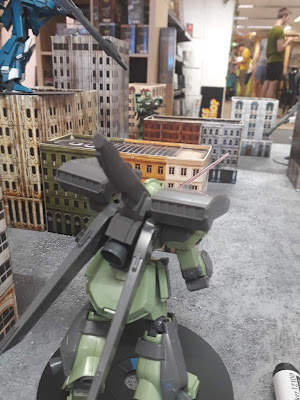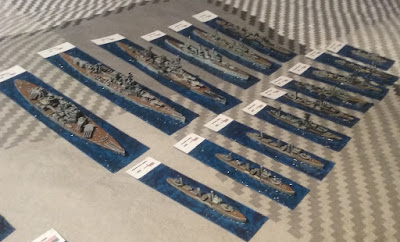A couple of weeks ago, I was reminded of the existence of Mobile Suit Skirmish, a fanmade ruleset for battles between suitable large mechs like those found in the Gundam franchise.
Reading up on it, it seemed quite interesting and playable with the 1/144 scale model kits I already had a bunch of.
After making some bases with line of sight markings out of some spare CDs and figuring out some small but somewhat balanced forces based on my collection, it was time to head to the local gaming store and finding an opponent.
For this test battle, I'd decided to leave out the additional morale and commander rules, which would keep things fairly straightforward while not missing out on too much.
The two forces were:
- ReZEL commander type with mega beam launcher (the big blue machine)
- Jegan with repeater beam rifle and shield (the light green machine)
- Stark Jegan with repeater beam rifle and missile pods (the light green machine with dark grey armor)
- RX-0 Unicorn Gundam with bazooka, but without NT-D, shield etc (the white machine without a shield)
- RX-78-2 Gundam with shield and beam rifle (the white machine with the red shield)
- Geara Zulu with beam machine gun (the dark green machine)
There was some more equipment than noted (such as beam sabers and vulcans) but I won't go into all the details here.
My adversary decided he wanted to play with the team of grunt suits.
After deployment, he went first and moved up agressively with his Jegan and especially with the ReZEL.
In one leap, it landed on top of a building in the middle of the battlefield. It would have great lines of sight from there, but also dangerously exposed.
Meanwhile, the Stark Jegan simply walked forward and took a pot shot at the Geara Zulu.
A hit was scored and I elected to sacrifice the machine's shield since the alternative would be to leave it at only 2 out of its 5 integrity and with some manner of critical damage. I would, of course, still take half damage (rounded down to 1) as well.
Here is the Geara Zulu's stat sheet after that shot; crossed-through weapons were ones not equipped for this battle.
Note that the sheet also has a lot of space for tracking experience points, the physical and mental health of the pilot and traits and modifications gained through campaign play; this ruleset provides everything needed for running multiplayer campaigns with character progression as well.
On my first turn, I decided to return fire: the RX-78-2 opened fire at the ReZEL with its beam rifle.
Its first shot missed, but the second hit home and dealt some serious damage.
Next, the RX-0 also opened fire with its bazooka. It scored a direct hit which was not deflected by the ReZEL's armour, knocking the machine out. Somehow, the pilot escaped the destruction of his machine unscathed.
After scoring this kill, the Unicorn's pilot swapped his bazooka for a beam saber, ready to use his machine's incredible speed to get stuck in on the next turn.
The Geara Zulu also moved up behind one of the lower buildings and fired some mostly ineffective shots at the Jegan.
On his turn 2, my opponent decided to reposition his Jegan and take a shot at the Unicorn. The shot was a critical hit, dealing minor integrity damage but also damaging the machine's arms; this meant its attacks would now be much less likely to hit.
The Stark Jegan also moved up and fired some shots at the Geara Zulu, but they all missed.
On my next turn, I decided to start off by boosting the Unicorn forward into melee with the Stark Jegan. However, the arm damage mean all my attacks whiffed. So did the return attack with the Stark Jegan's vulcan guns, so both sides broke off the melee away from each other.
Since the RX-0 would not last long exposed in the open like that, I had the RX-878-2 boost forward to get into a positon to engage the Jegan next turn.
The Geara Zulu simply fired its beam machine gun at the Jegan some more, to no real effect.
The plan for my opponent that next turn was quite straightforward: shoot the RX-0 until it's destroyed.
The combined firepower of his two remaining mobile suits was just enough to get that done.
On my next turn, I had the RX-78 grab its beam saber and try to take out the somewhat damaged Jegan with a single piercing strike.
However, his stab failed to connect and both sides broke off again after some vulcan fire pinged harmlessly off the Gundam's armour.
However, this gave the Geara Zulu an opportunity: it let loose with its beam machine gun once more, finishing off the Jegan with a critical hit.
After that, it moved slightly to a position where it could advance on the Stark Jegan next turn.
The Stark Jegan, now alone and facing threats from multiple angles, moved into a position with cover against both of its adversaries and a clear line of fire to the Gundam.
One beam rifle shot hit home, dealing damage but not disabling anything critical.
The Gundam, still wielding its beam saber, moved in to try and stab the Stark Jegan. It managed to do so and deal some damage, but after it fell back out of the melee the Geara Zulu no longer had a possible shot at it.
Deciding to further corner my final target, I had the Geara Zulu boost forwards, into a position with cover that had a line of fire towards the enemy.
The Stark Jegan fired its missle pods and some more beam rifle shots at the Gundam, dealing critical damage to its head and arms but failing to destroy it.
Next turn, the Gundam swapped back to its beam rifle and fired it at the Stark Jegan but missed.
However, the Geara Zulu did not with its beam machine gun, taking the last of my opponent's units out of action.
The state of the Stark Jegan before my last turn.
Overall, I quite enjoyed this game. Things played quickly, even though both of us were new to the game. Weapon damage and unit mobility felt right for the scale and it felt like you really had to make meaningful choices.
This is certainly a game I'm planning to play more in the near future.




















































